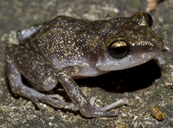|
Description
Eleutherodactylus pipilans is a small frog with snout vent length in males of 22.6 - 28.5 mm and in females of 21.1 - 29.4 mm. The body outline is truncate and from above the snout is oval. The eye is large and pupils are round. The tympanum is 36.5 - 54 % diameter of the eye, and vertically oval. The arms are long. Digit pads are slightly expanded or not expanded. Relative front digit length is 3 > 4 > 2 = 1 and has no webbing. The legs are relatively short. The inner metatarsal tubercle is slightly larger to under twice as large as outer tubercle. The skin is smooth to shagreened dorsally and smooth ventrally. Males have a vocal slit (Taylor 1940; Lynch 1970).
In life, the background color is dark brown to slightly lighter brown with yellow, orange, light brown, or greenish blotches or spots. The arms are banded. Preserved coloration is light brown with pale blotches (Lynch 1970).
There are two subspecies of Eleutherodactylus pipilans, E.p. pipilans and E. p. nebulosus that differ slightly in tympanum size and coloration. Eleutherodactylus p. pipilans tympanum size measured as 40.6 - 54.0 % diameter of eye size, which is larger than E. p. nebulosus’ 36.6 - 47.8 %. Color differences occur in spots, with E. p. pipilans having large light colored blotches or spots, and E. p. nebulosus having small light spots (Lynch 1970).
Distribution and Habitat
Country distribution from AmphibiaWeb's database: Guatemala, Mexico
Eleutherodactylus pipilans can be found in Mexico and Guatemala, occurring in southern Mexico as far west as Guerrero along the Sierra Madre del Sur, continuing southeastward through southern Oaxaca and Veracruz, into southern Chiapas and western Guatemala. The species inhabits tropical seasonal forest at elevations from sea. Eleutherodactylus pipilans can be found on or under rocks and under leaf litter (Santos-Barrera et al. 2004).Life History, Abundance, Activity, and Special Behaviors
Eleutherodactylus pipilans is a terrestrial species. Offspring have direct development. Males have distinctive mating call. Large population and a broad habitat range contribute to the species being listed as Least Concern (Santos-Barrera et al. 2004). Trends and Threats
Eleutherodactylus pipilans is reported to have a stable population trend by the IUCN. Its only major threat is habitat modification or destruction of tropical seasonal forests (Santos-Barrera et al. 2004). Relation to Humans
Previously described as Syrrhophus pipilans (Lynch 1970).
The species authority is Taylor, E. H. 1940. A new Syrrophus from Guerrero, Mexico. Proceedings of the Biological Society of Washington 53: 95-98.
The species epithet, pipilo means chirping or peeping in Latin, referencing the call of the male (Lynch 1970).
Possible reasons for amphibian decline General habitat alteration and loss
References
Lynch, J.D. (1970). ''A taxonomic revision of the Leptodactylid frog genus Syrrhophus Cope.'' University of Kansas Publications, Museum of Natural History, 20, 1-45.
Santos-Barrera, G., Canseco-Márquez, L., Muñoz Alonso, A., Acevedo, M. (2004). Eleutherodactylus pipilans. In: IUCN 2012. IUCN Red List of Threatened Species. Version 2012.2. www.iucnredlist.org. Downloaded on 19 March 2013
Taylor, E.H. (1940). ''A new Syrrophus from Guerrero, Mexico.'' Proceedings of the Biological Society of Washington, 53, 95-98.
Originally submitted by: Shawn Wright (first posted 2013-08-07)
Edited by: Ann T. Chang (2013-08-07)Species Account Citation: AmphibiaWeb 2013 Eleutherodactylus pipilans: Whistling Chirping Frog <https://amphibiaweb.org/species/3135> University of California, Berkeley, CA, USA. Accessed Apr 1, 2025.
Feedback or comments about this page.
Citation: AmphibiaWeb. 2025. <https://amphibiaweb.org> University of California, Berkeley, CA, USA. Accessed 1 Apr 2025.
AmphibiaWeb's policy on data use.
| 